Moonset over the solar farm.
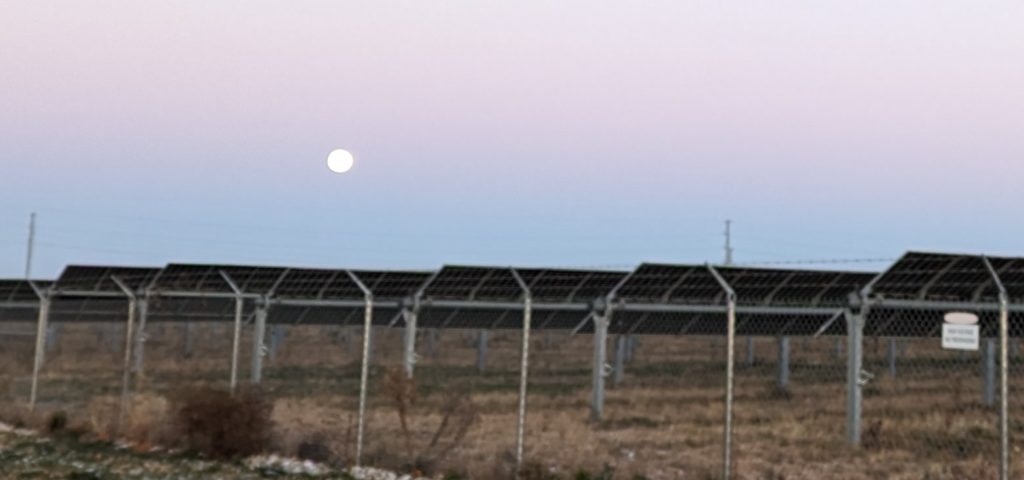

Moonset over the solar farm.

Dawn is pretty early this time of year—too early for me to see the sunrise, but not too early for me to get this picture.
About one minute after I took this picture, the solar arrays started to turn to point east.
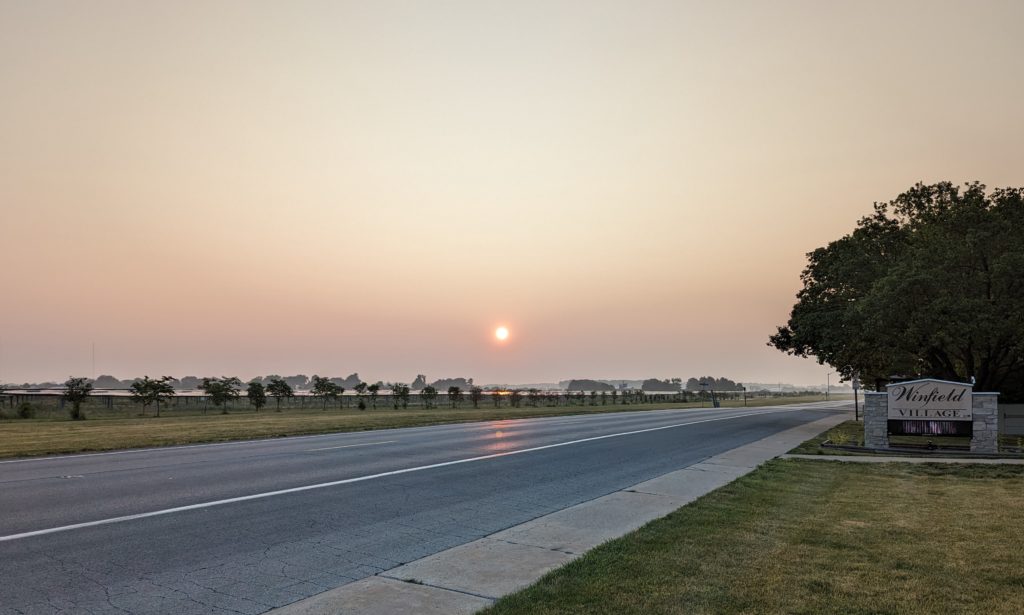
There’s a solar farm just north of Winfield Village, with ranks of solar arrays that turn from pointing east to pointing straight up to pointing west. (Oddly, they’re not arranged to point south. I assume the people who built it knew what they were doing, but I’ve been puzzling over it for a couple of years.)
The directions they point (and the timing of the changes) seem odd, and I’ve been trying to characterize the whole thing.
I initially assumed that they’d be programmed to point a particular direction based on ephemeris data about where the sun will be, but that seems not to be the case.
Here’s one piece of data: At dawn they do not turn to point east. Rather, they turn to point straight up:
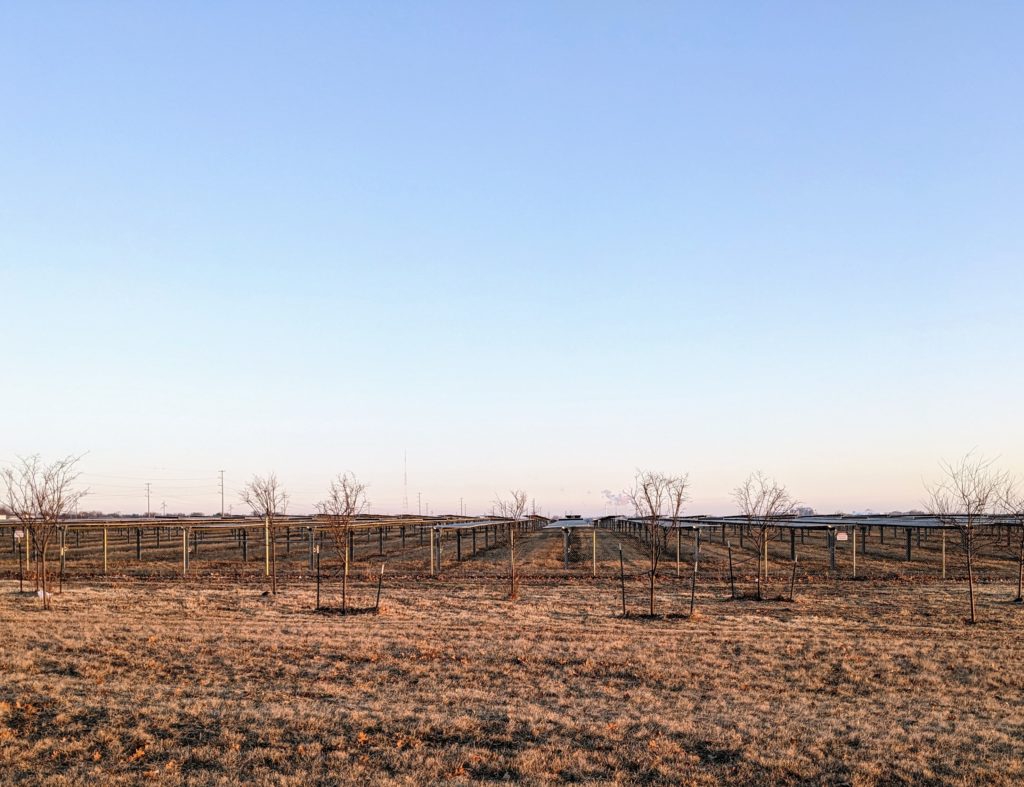
It is only after the sun is well up that the panels turn to face east.
Last night, perhaps an hour before sunset, they were pointed about halfway between west and straight up. Which kind of makes sense, as there were clouds to the west, so they clear sky straight up was probably as bright as the sun behind the cloudy sky.
My current working theory is that the panels turn to face whatever direction produces the most power, regardless of where the sun is in the sky.
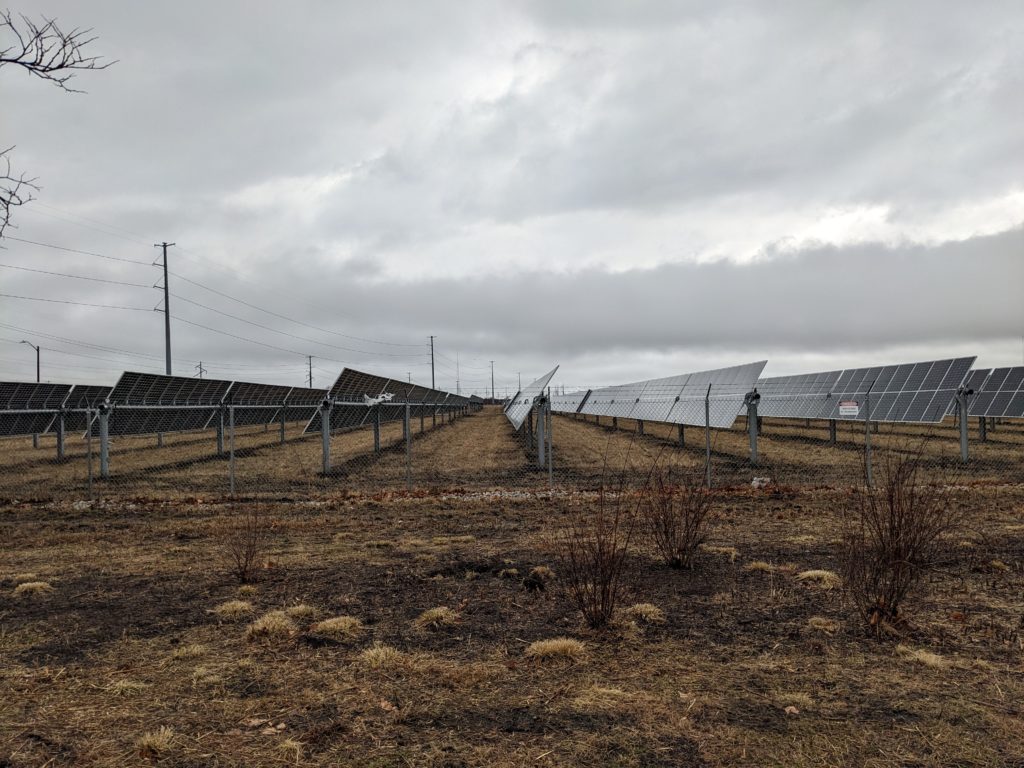
I’ll continue to watch, and try to characterize their behavior further.
Maybe I’ll even get in touch with the University and see if they can provide a link to a description!

Just like cell phones trained us to accept downtime that wireline customers the second half of last century would have considered outrageous, smart grids will too—as I said in 2017: What cell phones teach us about the power grid.
“… when the grid is unavailable, appliances and management software will collude to conserve electricity while trying to keep users comfortable and preserve food in the fridge or the charge on a laptop.”
Source: https://wolfliving.tumblr.com/post/670902474742317056/off-the-grid-iot
I’ve read several novels lately with characters engaging in the sort of OPSEC that you need to do nowadays if you’re undertaking activities the federal government would consider nefarious—beginning with not carrying your smartphone around everywhere you go.
Of course you wouldn’t want to leave your phone behind only when you were doing something nefarious. To do that would be like announcing “Nefarious activity beginning now!” Instead, you need to start playing at going off the grid now for no particular reason, so that when you go off the grid for reals it won’t be so obvious what’s going on.
The necessary OPSEC is hard to get right. One of the novels I mentioned, (The God’s Eye View by Barry Eisler) has as a significant plot element how easy it is to screw up. In the novel a character’s actions are discovered due to her turning on her burner phone at a point close in time and place to where she turned off her regular phone.
As a slightly more sophisticated example, the NSA is known to have a system for “fingerprinting” burner phones, which works by spotting when one cluster of related burner phones all go dark at the same time, and then a similar-sized cluster, with a similar pattern of connectedness, starts up right after.
Just spending some time out and about without a cell phone is probably a good start. Establish a pattern of turning your phone off (or leaving it at home) for a couple of hours every day. It might make sense to establish a regular pattern of doing so, but one can easily go awry trying to set up false patterns. Perhaps it would make more sense to have no particular pattern of when the phone might be on or off.
Purely whimsically, I’m inclined to do this.
In fact, I’m going to have to: Next month I’m on jury duty for a week and cell phones aren’t allowed in the courthouse. I’m sure most people leave their phones in the car, so they can return to them over their lunch break, or at least get back to it as soon as they’re released at the end of the day. But the courthouse is in downtown Urbana, a place that’s easy to get to by bus, so I’m disinclined to drive there. But without a car in which to leave my phone, I’ll probably have to leave it at home.
That might mean 8 hours or more being out and about without my phone, which seems like a great opportunity to establish a pattern of my phone being left home while I do something else—serve on jury duty next month, but who knows what the month after? Nothing nefarious, of course. I’d never do anything nefarious.
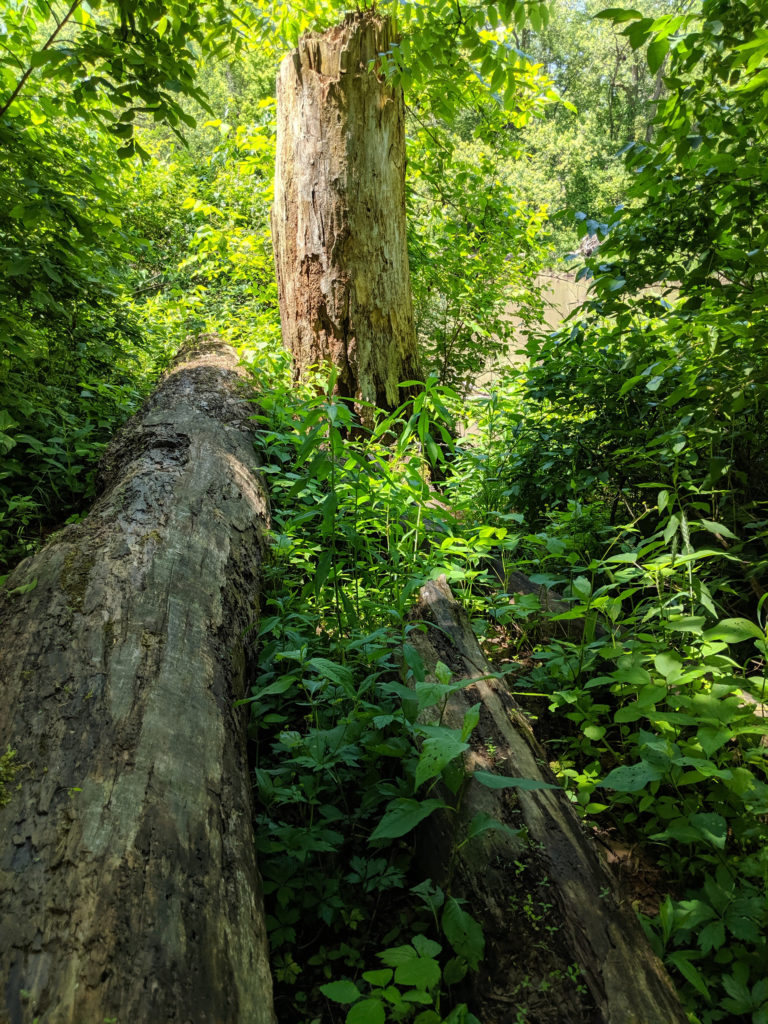
Even places where cell service is spotty, such as this spot on the trail in Kennekuk Cove County Park, having a smartphone is completely normalized for me. I expect to be able to just take a picture like this. (And the idea that I might instead bring a camera almost doesn’t fit in my brain any more.)
As an aside: I wrote a couple of articles about going off the grid back when I was writing for Wise Bread. One was a book review of a rather interesting book titled Off the Grid. The other was an article about the trade-offs in choosing to live “off the grid” in the broader sense—not just off the surveillance grid, or even the power, gas and water grids, but more broadly the globalized economy, industrial agriculture, consumerism, etc. I can’t remember what I called the post, but Wise Bread published it as Going Off the Grid Is a Lot Harder Than You Think.
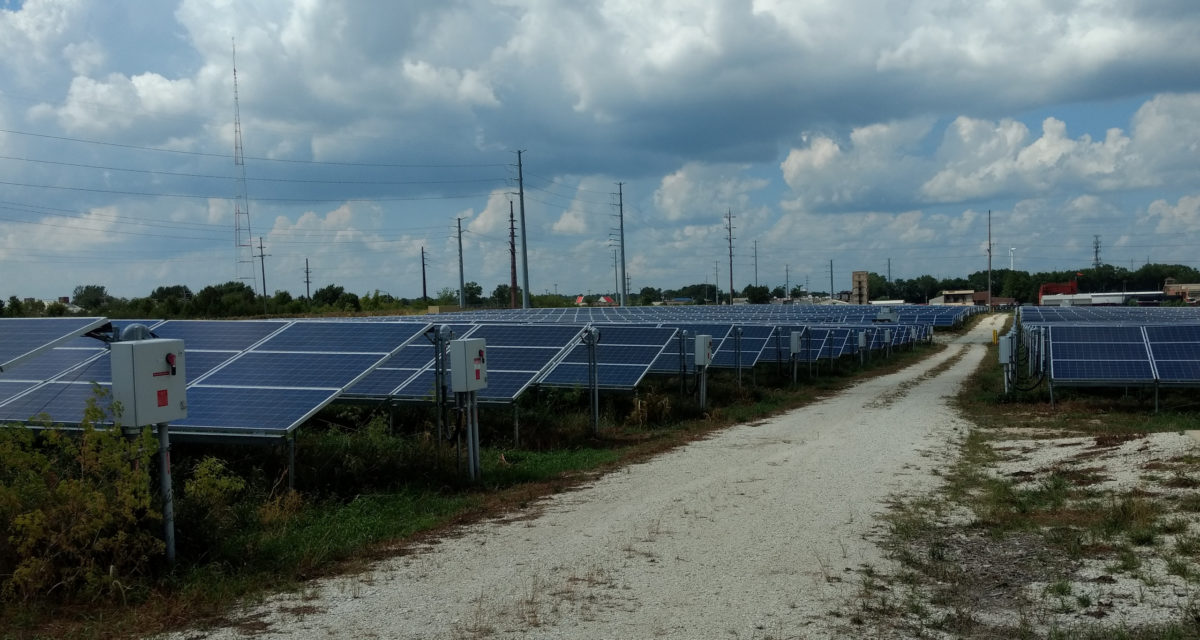
Yesterday’s eclipse prompted me to go look at the day’s power production from the University of Illinois’s solar farm.
Just eyeballing the graph, I’d estimate that eclipsing 94% of the sun reduced power production by about 94%.
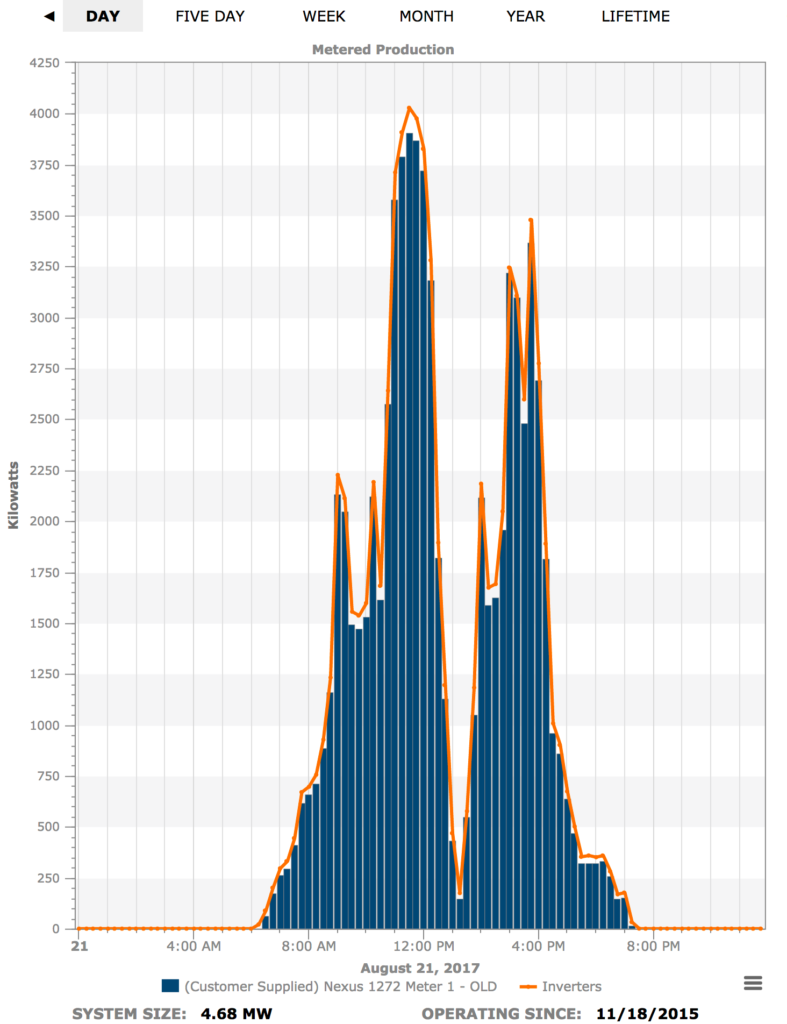
The solar farm is exactly one mile north of Winfield Village. Jackie and I got a tour of the facility a couple of months ago and I got some pictures besides the one at the top, but haven’t gotten around to writing my solar farm post yet.
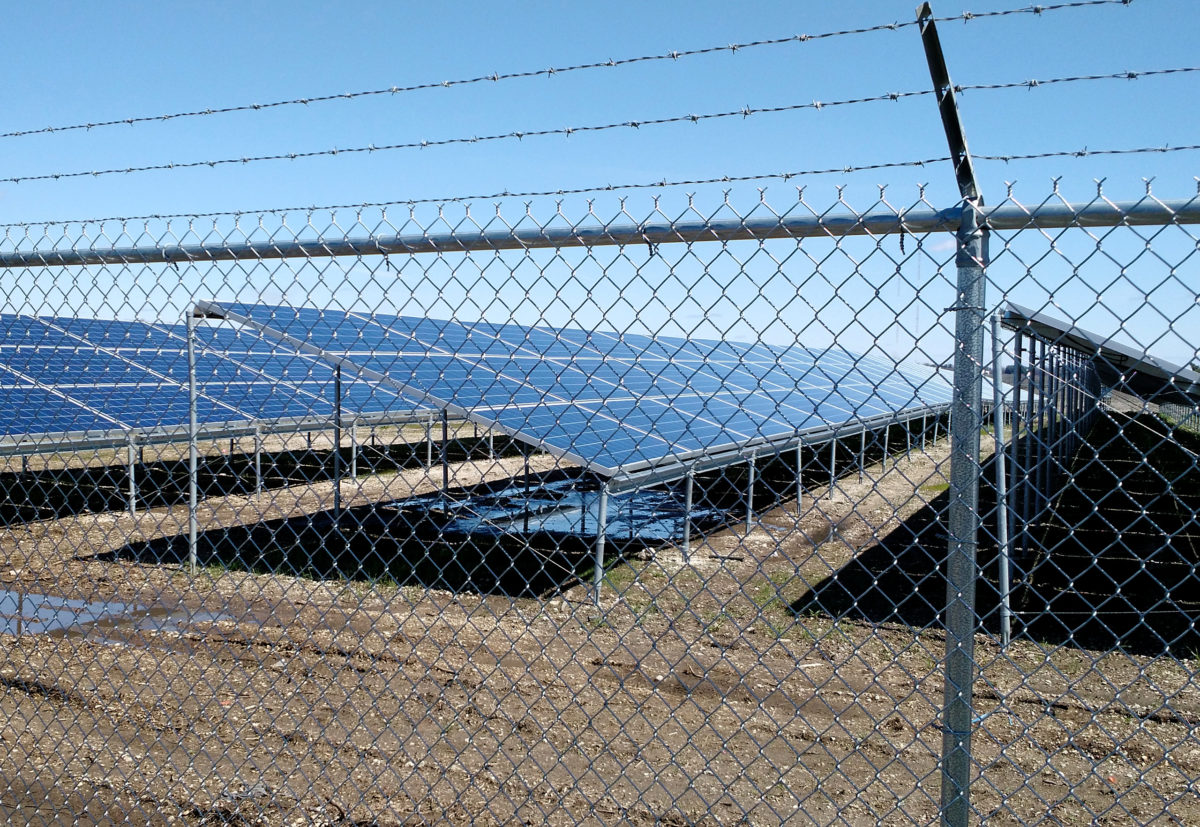
Back in the day the telephone network was a regulated monopoly. As long as the phone company kept the regulator happy, they were permitted to earn a profit on their investment. This resulted in a couple of interesting effects.
First of all, the company was incentivized to invest more in infrastructure: The more they invested, the higher their profit (which was a regulated rate times the size of their investment). This is very different from an unregulated company, where investment is viewed as a cost.
Second, while keeping the regulator happy was always a complex dance, the regulator tended to focus on a few key metrics, one of which was network uptime. This incentivized the phone company to use that large infrastructure investment to produce a network of extreme reliability.
And that network was reliable. In my personal experience with wired phones in that era a wired phone always had service: For two decades as a youth I had literally 100% success picking up a phone and getting a dial tone. Likewise, calls did not drop. Service was rated in nines: 99.999% uptime was 5 nines, 99.9999% uptime was 6 nines.
Of course, that sort of reliability is impossible with cell phones. They move around. Worse yet, they go places where radio signals simply can’t reach.
Cell phone reliability is pretty darned good—let’s call it 98%, as long as you’re not trying to get service in places where nobody else cares if there’s service (the middle of the desert, the middle of the ocean, etc.). But people are not surprised when they find a spot where there’s no service, nor are they surprised if a call drops when elevator doors close or they drive into a tunnel.
This is not to say that cell phone service is bad. My point is simply this: To get the advantages of cell phones, people have accepted a drop in telephone service reliability from six nines down to less than two.
I think this is particularly of interest because I see a potential parallel with the power grid.
The big problem with solar and wind power is that they’re crappy at providing baseline power, for obvious reasons: nighttime, cloudy days, calm days, etc.
If you want a power grid to provide five or six nines of availability, you really need to have enough fossil fuel (or nuclear) generation capacity to provide a large fraction of your total power needs—at least 80%, probably more if you don’t have considerable diversity in your renewable sources (both diverse sources: solar and wind, and geographic diversity: the wind is always blowing somewhere and the sun shines different hours different places).
But just as people learned to get by with less than two nines of phone network reliability, people could certainly learn get by with a less reliable power grid as well.
Thinking of household use, there are certain things that really need fairly reliable power (refrigerator, freezer, furnace), but beyond those few things, we only require a high-availability grid because we’ve set things up with the expectation that it would be there.
Just two or three modest changes to the way we use power could easily accommodate a less-reliable grid.
The easiest one would be for each household to have a guaranteed level of power—enough to keep your food fresh, your pipes unfrozen, and a couple of lights turned on—and then make additional power available on an as-available basis. Alternatively, you could go with a market-based measure where power was cheap when it was plentiful and expensive when it was scarce. A third option would be to distribute the resiliency, with each household providing its own backup power storage or generation capability.
My point here is not to solve the issues for a smart grid, but just to make this point: For a big enough payoff—like the payoff of a internet-connected supercomputer that you can carry in your pocket—we would accept a considerable downgrade in reliability from our power grid.
The payoffs from renewable energy arguably are that big. (In particular, not rendering the planet uninhabitable for humans. But that’s a payoff that’s uncertain and diffuse, with the gains—especially the early gains—going to people other than the ones who need to make the sacrifices.) But there are payoffs to everybody: less particulates in the air, fewer pipeline and tanker spills, fewer truck and rail accidents hauling coal and oil through towns and cities, fewer worker deaths in the coal-mining and oil-drilling industries. And then there are the cost savings: Renewable power has the potential to be very cheap and very reliable in the out-years, once the infrastructure has earned out its initial capital costs.
It might well be worth getting past the idea that the power grid should provide near-perfect reliability, given the payoffs involved in accepting a bit less.

There’s a dearth of good walking routes from Winfield Village to Champaign and Urbana.
From west to east, the choices are Prospect, Lyndhurst/Fox Drive, Neil/Route 45, First Street, and Race Street. The first two are okay if we’re heading to western or central Champaign, but are pretty out-of-the-way if we’re headed to campus or to Urbana. The latter two lack sidewalks and entail long walks along busy roads, which makes them pretty unsatisfactory.
A few weeks ago, I saw a pack of cross-country runners turn up a rather faint double-track on this side of the railroad, which alerted me to the fact that it’s possible to go that way.
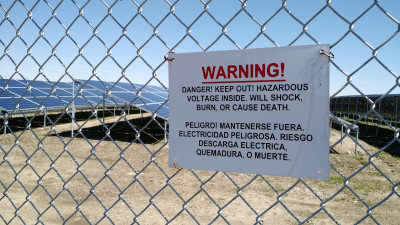 I was doubly interested in going that way, both as a possible alternative route north, and because about one mile north of us there’s a large installation of photovoltaic panels that the University has been calling its “solar farm,” and this bit of double-track leads right to it.
I was doubly interested in going that way, both as a possible alternative route north, and because about one mile north of us there’s a large installation of photovoltaic panels that the University has been calling its “solar farm,” and this bit of double-track leads right to it.
The track runs along the west side of what seems to be research crop fields for the University, although that bit of it may be an easement to provide access to a recently constructed line of pylons for some high-tension power lines.
The solar farm seems to producing quite a bit of electricity on sunny days like today.
Having walked to the solar farm we turned east. Having come that far instead of having to walk a mile along First Street, we only had a quarter of that distance to cover before we reached Windsor and were able to get on a proper sidewalk.
We took a nice tour around the more obscure corners of the research park, including a little diversion past the Fire Service Institute’s training facilities. Then we crossed Route 45 and made our way down to Schnuck’s to pick up a couple of groceries and head on home.
Total walking was 7.7 miles, in my case added to a 3.5-mile morning run.
I had not done much running since settling into the low-carb thing. Together with the walk, it’s a bit of a test of whether I’m seeing any of the endurance benefits I’m hoping to see. (Answer: Maybe. I certainly didn’t get hungry or feel a need to fuel up during the walk. But then, neither did Jackie.)
I was reminded yesterday that I wanted to mention Property Assessed Clean Energy, which came up in the course I’m taking on electric power. (What reminded me was Tobias Buckell’s post about how the real issue for photovoltaics is the capital cost of installing the capacity, which he mentioned in reference to a rather interesting article on issues with solar feed-in tariffs.)
Property Assessed Clean Energy (PACE) is a clever idea for funding homeowner investment in solar power. The way it works is this: The municipality raises money with a bond issue, then lends it to homeowners to invest in solar (or potentially wind) power generating capacity. That investment is then paid back to the municipality over 15 or 20 years via an assessment on the property tax bill. The money is easy for the homeowner to pay back, because the debt repayment is funded by savings on the power bill.
The property tax assessment stays with the house if it is sold, which is reasonable because the photovoltaic system or wind turbine stays with the house as well. This means that the capital is available quite cheaply, because the money is very likely to be paid back.
The really big win of PACE is that it greatly reduces the biggest financial risk that a homeowner takes when making an investment in solar power—the risk that he or she will end up having to move before the rather long payback period, and end up being on the hook to pay the loan back, without enjoying the benefits of the lower power bills.
The problem is, even though about half the states have laws authorizing some form of PACE, the whole scheme has been blocked by the Federal Housing Finance Agency, which instructed Fannie Mae and Freddie Mac not to underwrite mortgages on properties with a PACE assessment.
As I understand it, the issue is that the property tax assessment (like property taxes in general) are senior to the mortgage in the event of a default. But if this regulation is legitimate, the federal mortgage authorities can regulate all municipal activity. They could ban mortgages on houses where the municipality is funding public art through a property tax assessment (or on houses where the municipality isn’t funding public art). If this principle stands, municipal governments will have to do whatever the mortgage authorities demand, or else only people rich enough to pay cash would be able to buy a house in town.
There’s a group called PACENow that’s working various paths to get the prohibition reversed.